
 |
|
|||||||
| Home | Forum | Online Store | Information | LJ Webcam | Gallery | Register | FAQ | Community | Calendar | Today's Posts | Search |
 |
|
|
Thread Tools | Display Modes |
|
|
|
|
#1 |
|
Senior Member
Join Date: Feb 2010
Location: Clairemont
Posts: 813
|
|
|
|

|
|
|
#2 |
|
Senior Member
Join Date: Jun 2010
Location: Under a bridge
Posts: 2,169
|
Solution 1: Drink your beer faster.
 Solution 2: Learn how to hold your rod and reel in a 40lb YT at the same time, with ONE hand! 
|
|
|

|
|
|
#3 |
|
.......
Join Date: Jan 2009
Posts: 1,509
|
My kayak Hoopnet
I originally posted this in back in 2006 on another board, but I was going through some archives, and found it again so I thought I'd re-post it here.
So....Here it is...my kayak hoopnet....  The nets one of my designs: essentually a redesign of this net I made in 2005 using the same netting:  It was a "working" prototype that I'd been playing with for while, but I had some issues with it. The first net had too big of an opening which produced too much drag in the water. Th newer one has the same size opening as a Danielson cone but the top ring is an inch and a half higher, and the base is only 28 inches across vrs 34 inches on the Danielson net and 36 inches on the Promar net. Since the base is smaller it has a lot less drag coming up through the water. It pulls easier and faster then either the Promar or the Danielson net. Like the Promar cone, my net folds down for flat storage.  I don't know how theirs work as I never owned one but my design has three pieces of pivoting 1/2 inch tubing that that turn on the 1/4 inch stainless hoop ring. The bridle is made from three lengths of 250 pound Mono leader. It runs down through the tube legs and it's tied to the Bottom 3/8 hoop. Basically to get the hoop to stand up and pull into shape you just have to pull up on the bridle.   Once it's up you just have to make sure the knots go up into the legs and it's ready to use.   I've pretty much got this one worked out. It's a great net. It sinks like a stone, pulls easy as Promars original smaller flat nets, and catches more bugs then they do. From playing around I've pretty much figured out that the crucial distance in a cone net is not the diameter but the entrance or top rings distance and height ratio to the bug. Most bugs are lost one of two ways in a basket style net. Either the bug flips over the ring before it gets high enough to block his initial jump or climbs out on the way up. So the advantage of larger Basket style net compared to a smaller one is the ring edge is simply further from the bug at the start of the pull. Conical nets do not have the same constraints With a conical net the top ring is already above the bug: the idea being it is it's high enough to make it hard for the bug to intially flip out. It's all about exit angle. When the exit angle is too steep for the bug to make on his first flip he undershoots the exit and ends up stuck backwards against the net wall or downward facing side. If he keeps flipping he just drives himself deeper into the net. The crucial distance is then not base diameter on a conical net but the entrance ring distance and height ratio to the bug. I can't figure out why the net manufacturer's have not figured that out but even the new Promars are much larger at the base which makes them harder to pull. Here's the old style cone geometry compared to my new net:  The larger the top ring diameter or the lower the ring, the better the angle is for swimming out. So the trick is to have a relatively small opening high enough above the bugs head that he can't make the angle when he tries to kick out. I've not used the Promars cones at all but I have a few Danielson conical nets. The D cones are made like traps. I think the guys who designed them thought that lobsters would climb in, feed, then not be able to find their way out. I don't believe that at all..... . Crabs...maybe.... but not lobsters. I've watched bugs feed in my Danielson nets with my IR Infrared camera and once they feed they get out fast. The Danielson nets work great but my three gripes are..... One: I think the top ring is too low and that bigger bugs sit on top and feed without getting in the net . Two: they hard to pull because they are too big and too heavy. Three they take up a lot of room in a boat and are impossible to carry on a kayak. The plus side you don't have to pull them that fast because once you have a bug in them it's very hard for them to get out. I have not used the larger Promars but I can tell just by looking they are an improvement in two ways. One the top ring is too high for bugs to perch on and feed and two: they fold for storage. Still they are huge, heavy and I bet they are a biiiiittttch to pull.  One thing for certain: Now that Promars come out with a two cone nets and the DFG has OKd them there is no doubt that cone nets are here to stay.  Cones are ideal for kayak because it's hard to pull as fast when your sitting down. Unfortunately the current ones commercially available are probably a little harder to pull then they need to be. Here's one more pic a standard D cone on top of my cone.  You don't have to be a rocket scientist to figure out why mine pulls easier, and with it's higher ring it should catch more and larger bugs. I have no plans to market these nets right now but they could be marketed. I think it's pretty much the ideal net for Kayaking. Seems to work so far for me:  ...and your welcome to make your own. Tight lines, Jim Last edited by Fiskadoro; 03-29-2011 at 06:03 AM. |
|
|

|
|
|
#4 |
|
Senior Member
Join Date: Feb 2009
Location: SAN DIEGO
Posts: 1,086
|
Hey Jim,
The DFG is providing two operative definitions of a legal hoop net, lies flat on the ocean floor as well as the new style hoop net that has thein order to accommodate the gear configurations that are currently in use by the public. The definitions will include the traditional style hoop net that second smaller ring that is held above the ocean floor. Is it legal to modify these two types of nets? I can't find any info were it says you can or can't. |
|
|

|
|
|
#5 | |
|
.......
Join Date: Jan 2009
Posts: 1,509
|
Quote:
Any time you do something like this you have to look at the regs. I made my nets before they made the new regs, but I have been told that these nets of mine fall under the current guidelines for cone nets. I kinda lucked out because they are my favorites and my most successful design I actually have several other designs that I imagine are now no longer legal, as they were flat nets with additional rings that pull up in the shape of cones. It's my understanding that anyone can make thier own nets or modify nets, but any nets you actually put in the water must conform to the size and configuration guidelines put out by the DFG. The only issue I could of had with these nets is the size and height of the top ring, since my top ring was the same size as a Danielson cone in diameter, and around the same the same height as the top ring of the Promar eclipse nets. my nets are within the legal dimensions the DFG created around both those production nets. Bottom line though is you can make your own hoopnets. Jim Last edited by Fiskadoro; 03-29-2011 at 02:43 PM. |
|
|
|

|
|
|
#6 |
|
Senior Member
Join Date: Feb 2009
Location: SAN DIEGO
Posts: 1,086
|
The new promar eclipse was approved by the DFG becase its spec's were
similar to the old traditional hoop. Have you cheked with the DFG about modifcation/configuations/mechanisms of your new hoop net? Might be worth checking just to be sure. http://www.promarnets.com/Media/Arti...-10/P1-P14.pdf |
|
|

|
|
|
#7 |
|
Senior Member
Join Date: Jun 2008
Posts: 552
|
Don't forget, that you don't want to violate the new soak limit!
  Nice nets Jim! |
|
|

|
|
|
#8 | |
|
.......
Join Date: Jan 2009
Posts: 1,509
|
Quote:
It's not a big deal but I think you have some basic misconceptions. First off the original hoopnets were all flat two ring nets made for the sail powered commercial crab fishery in San Francisco bay. They predate the use of traps back to the 1800s. The Danielson cone nets are a more modern net designed for dungeness crab, but built for the rec crab fishery with a rigged structure more like a trap, then a traditional hoop. When Guys started using them for lobster down here there was a big shakeup. Some in the DFG said they were illegal for lobster, some guys got tickets for using them, and the official word was that they essentually were traps. The deal was the regs did not have a clear definition of what a hoopnet was so legally there was a loophole and for a while it was pretty much anything goes. The DFG siad they were going to remake the regs, and part of it would state that all hoopnets had to be flat nets. That they had to lie flat on the bottom, and be under 36 inches in diameter. Since it was obvious that cone nets did not lie flat they were going to be illegal for lobster, but still legal for crab. That said cones had some advantages, so some of us started playing with alternative flat nets, that had cone properties. Here's one of mine from back then.  That extra expandable ring caused the net lay flat with the bait cage centered, but also when pulled changed the net to a cone shape. The idea being if nets just had to lie flat that net would be legal but it also functioned like a cone net. I used those nets for one season and they worked great, but had a lot of drag in the water. Though legal back when I made them, it's my understanding that they would now be illegal because it has too many rings according to the new regs. Promar in anticipation of the Flat net reg held back on making conical nets and instead introduced the larger 36 inch flat nets to get a jump on Danielson, who was only making 32's. For a while 36 flat nets were the hot item, in anticipation of the reg change, but they are dogs to pull, and some of us switched to motorized pullers. (I made my own) Bottom line we were all trying to figure out how to legally maximize our catches, and wanted to know what the new regs would be so we could build nets to fit them in anticipation of their arrival. The rub for Promar though was the DFG did not change the regs, but stalled out on it, and started talking about doing a study. That put Promar in a bind. Danielson was making a cone net, legally selling it, it was getting popular, the DFG quit writing citations, so Promar needed to compete, or they were going to loose some of their business. Now I don't know what Promar officially says but after waiting for a few years for the DFG to act on the flat net regs Promar in my opinion just had enough and they made a even bigger cone net the eclipse net to essentually challenge the law. Like Promar I had held back on making a cone net for years because I'd heard they were going to be illegal but when I heard about the Promar eclipse going into production I was like screw this I'm going to make my own cones as well. At the time I just started kayak hooping, so I started playing around with a low drag kayak friendly cone hoop design. I had a friend in the DFG who warned me against doing it, because he said they still were considering a reg change, but I figured WTF I could use them for a season or two, and since the DFG would either have to outlaw cones altogether, or that they would have to permit both production cone nets to keep being made, that if I built my nets with net specs that lay right smack between the two production cones, I could maximize the chance that my nets would still be legal when and if the DFG finally did actually change the regs. Of course if I was wrong I'd of just changed the nets, or scrapped them, I mean I have maybe six net designs around here, some in full sets, but the day the DFG came up with the new regs I got a call from someone closely involved in the process and they assured me that my nets were still going to be legal. So it worked, and you could say I have checked, or do have confirmation that my nets are legal. Bottom line you can build your own nets as long as they fit the specifications spelled out by the DFG, and my nets fit those specs even though they are easier to pull from a kayak then the current D and PM designs. Jim Last edited by Fiskadoro; 03-30-2011 at 08:17 AM. |
|
|
|

|
|
|
#9 |
|
Junior
Join Date: May 2011
Location: Bakersfield
Posts: 9
|
ocean kayak ff mount mod..(echo..echo..echo)
Just in case anyone out there rides one of these awesome fishing machines here ya go..
Basically its an extending arm mount for a fishfinder. It is completely watertight and mounted in the back of the sonar compartment on Ocean Kayaks. I found that ff screens are easier to read up close and that they dont like being flopped on by fish! All the cables are mounted through the shaft of the extending portion. The internal housing consist of a sealed, straight flush mount rod holder. The tube rests on top of the battery bag. The tube extends down at an angle but does not contact the hull or Fishing rods that may be stored inside it. Easily tucks in with one hand while fighting fish with the other. Last edited by superpoly76; 05-08-2011 at 07:26 PM. |
|
|

|
|
|
#10 |
|
Junior
Join Date: May 2011
Location: Bakersfield
Posts: 9
|
pics
Hope this helps...somebody? |
|
|

|
|
|
#11 |
|
Member
Join Date: Jan 2009
Location: Los Angeles
Posts: 69
|
This not really an innovation, it's cheap and keeps things real simple and functional.
All that's needed is black Sharpie marker and tape measure. Makes for easy fish measuring.  I'm right handed so I just put the measurements on the right hand side. I might ad the measurements lines on the other side of the Xfactor as well. |
|
|

|
|
|
#12 |
|
Member
Join Date: Jan 2009
Location: Los Angeles
Posts: 69
|
These are just some things I've seen and read about on this site and others. Lots of cool innovations for sure. I wish I could have contributed some of my own ideas, but I'm just not one of the creative type. Anyhow I hope these photos can help others out as past images and instructions have helped me out.
Bait tank battery box mounted directly onto the crate with zip ties. I drilled out two holes for each zip tie on the inside of the box (a total of four zip ties were used), once the zip ties were through the battery box and tight to the box I added marine goop to keep the water from entering through the holes.  I'm using this type of deck connector from the bait pump to the battery box. It seem like it could come unplugged really easy but we'll just wait and see how it works out.   The other side of the battery box has a toggle switch for turning the power on and off as needed.  ABS pipe cut to about twelve inches and then zip tied to the crate. The small cord is for tying down the rods just in case I roll while out on the water, so hopefully I will not loose any of my gear.  On the Vittles Vault bait tank I drilled some small drain holes, these work perfect with the Rule 360 bilge/bait pump and a 6v 7ah battery with the Mojo timer set at a fifteen seconds on and fifteen seconds off cycle.  On the lid of the bait tank I drilled out a small hole to put the cord through so that I will not accidentally loose the lid while on the water or land for that matter.  This just a small knot tied on the inside of the lid, simple yet effective.  Thanks for the great ideas guys! Last edited by Flyfisher70; 05-24-2011 at 03:56 PM. |
|
|

|
|
|
#13 |
|
Currently @ MLO Territory
Join Date: Dec 2010
Location: Under the Shadow
Posts: 2,290
|
Yard Sales
Well being the professional yard sales man that i am.
I started thinking of new ways to stow my gear on my X-factor when i am launching and landing.   After i got tired of my transducer falling off while carrying it upside down i made my transducer act exactly like a rudder i even attached a pull string to come up when landing and launching.  
|
|
|

|
|
|
#14 |
|
Member
Join Date: Mar 2009
Posts: 31
|
Hobie Pro Angler Tandem for the little one
I used to have a gator hatch on my malibu that my daughter loved to sit on while we fished in lakes and especially in the sierras. anyway the mirage drive temptation got the best of me and I went with a revolution which after about 6 months broke my daughter's heart because she couldn't go to the lake with daddy.
Solution: Pro Angler with a front swivel seat mod. Seat $25 Swivel mount $10 Detachable seat mount $20 Stainless hardware $12 Lumber $6 The detach mount allows me to take the seat on and off. |
|
|

|
|
|
#15 | |
|
Senior Member
Join Date: Mar 2010
Location: Santee
Posts: 904
|
Quote:
|
|
|
|

|
|
|
#16 |
|
Olivenhain Bob
Join Date: May 2008
Location: Olivenhain, CA
Posts: 1,121
|
This should be a chapter in the manual that none of us received when we came home from the hospital with our children.
I can see it now, Parenting 101. The chapter heading... Teach your kids to love what you love. Well done Slappy. Did she catch that fish? Bob |
|
|

|
|
|
#17 |
|
Member
Join Date: Mar 2009
Posts: 31
|
Oh she caught them all. Sometimes Dad has to remind her "Addison where is your bobber?"
|
|
|

|
|
|
#18 |
|
Senior Member
Join Date: Mar 2010
Location: San Diego
Posts: 2,385
|
Electrical Putty Installation of Transducer
Electrical Putty Transducer Installation
Not happy with the wet installation results of my transducer I remembered a Youtube video a friend of mine, John Oast, did about installing a transducer with Electrical Putty. http://www.youtube.com/watch?v=3u1d3_UeD3k http://www.youtube.com/watch?v=GEZ9_C1iKP0 I went back to watch how he did the installation and found another video of someone who tested it on 3 different Kayaks with a couple of different installations. I chose to follow what John did with his transducer. Here are the materials needed, I did not photo the Marine goop but that is needed to secure the sponge to the Kayak in this method of installation. 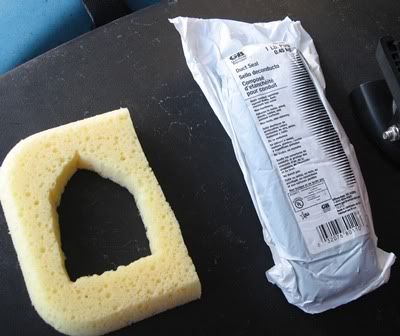 I like having the ring to be the guide for where the transducer is going to be installed. 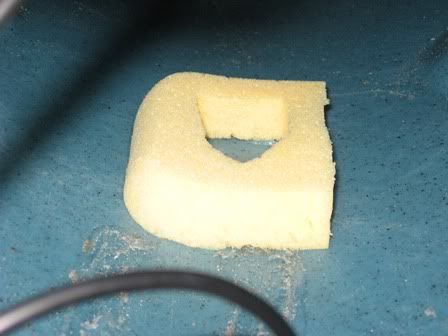 First I cleaned the area with alcohol prior to gluing the sponge. Then I glued the sponge into place and let that sit for about 5 minutes. Then I opened the putty and cut off a little chunk. I then formed that into a small flat slab to put in the center of the sponge opening, making sure to really mush it around to fill the opening.  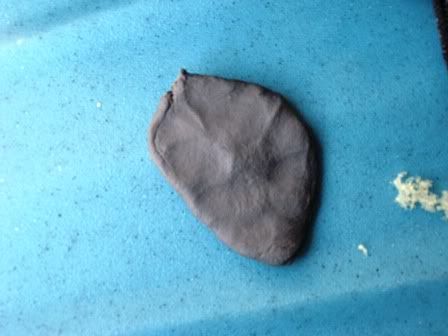 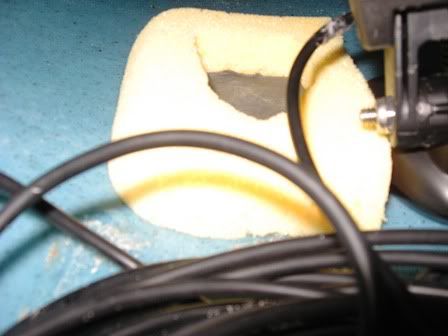 Then I stuck the transducer in the opening and rocked into place. 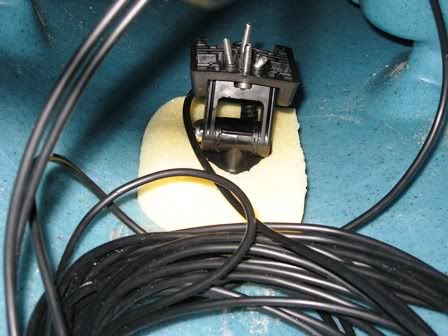 This Putty is sticky and does not let things slip. Prior to launching I made sure the transducer did not move and it had not.  I am very happy with the results I found that the readings were right on, depth wise, and temp wise. The best part to this is I can move the FF to another boat, or Kayak at any time. Cost of the sponge - 99 Cents Cost of Electrical Putty - $1.29 Home Depot Marine Goop and Alcohol already on hand. Time spent on installation including driving 30 minutes. Watch the videos I have included there is a way to install without gluing anything to the hull. Great option if you don't want to glue anything to your hull.
__________________
No better time than being on the water, God Bless, JimmyZ 
|
|
|

|
|
|
#19 |
|
Olivenhain Bob
Join Date: May 2008
Location: Olivenhain, CA
Posts: 1,121
|
Good job Jimmy. Your method is similar to the grease mount version that I currently use. The wet mount, while very effective can have some problems, most notably leakage.
If you do not see any loss of performance with the putty, this may be a good find as the putty should be less messy than the grease. My only concern would be what happens as the putty ages and dries out. Please keep us posted. Bob |
|
|

|
|
|
#20 | |
|
Senior Member
Join Date: Mar 2010
Location: San Diego
Posts: 2,385
|
Quote:
__________________
No better time than being on the water, God Bless, JimmyZ 
|
|
|
|

|
 |
| Tags |
| kayak fishing inovations, kayak rigging ideas |
|
|